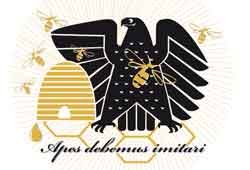- Hardcover: 244 Seiten
- Verlag: Borntraeger
- Autor: Ingrid Roth
- Auflage: 1. Aufl., erschienen am 15.07.1991
- ISBN-10: 3-443-14018-1
- ISBN-13: 978-3-443-14018-2
- Größe und/oder Gewicht: 24,0 x 17,0 cm
Handbuch der Pflanzenanatomie. Encyclopedia of plant anatomy. Traité d’anatomie végétale / Leaf Structure of a Venezuelan Cloud Forest
Autoren: Ingrid Roth76,00 €

HONIGHÄUSCHEN (BONN) – By the expansion of the population and the refinement of techniques, tropical vegetation is more and more endangered. Particularly the tropical forests are destroyed by the spreading of the indigenous agriculture as well as by the clearance of forests to obtain timber for various purposes. For thousands of years the indigenous population lived in a stable equilibrium with the environment, maintaining the existing ecosystem. In our modern times, however, the whole world seems to be involved in a rapid destruction of what has been left of the humid tropical forests. But our knowledge of an adequate management of these forests in order to maintain their natural characteristics as well as their productivity is very limited. Just as poor is our awareness of the real economic value of the humid tropical forests. However, exploited reasonably they may constantly yield forest products of different kinds, such as wood, fiber, resin, latex, cork, oil, medicinal drugs, chemical products and others. Humid tropical forests, the richest manifestation of plant and animal life in the world, have evolved under relatively uniform environmental conditions so that an exuberant vegetation with a large variety of species but a small number of individuals per species has developed. It is estimated that 50–200 species may be found on a hectare, but only a few individuals of a given species. These ‚living laboratories‘ represent the most important gene pool of the world. However, they may easily become extinct when exploited without care. Many species are endemic, many sensitive to environmental changes. Seeds have usually a short viability. Interrelations between plants and animals are of great importance, particularly in the dispersal of seeds and fruits. It thus seemed worthwhile to dedicate a series of volumes of the Encyclopedia of Plant Anatomy to the structure of tropical plants to demonstrate the relationship between plant structure on the one hand, and environmental conditions on the other. A variety of ecological habitats in Venezuela have been studied by the present author in this connection. The present author has been teaching and doing research at Venezuelan universities for more than 20 years. Contacts have been maintained through many years and an exchange of Venezuelan and German scientists is still sustained. This interrelationship should be maintained for the benefit of future botanical studies in the neotropics. The cloud forest of the Parque Nacional Henri Pittier is one of the best known forests in Venezuela and probably in the whole of South America. It comprises a mountainous area of not less than 107800 ha. Its particular climate, the almost constant presence of mist and the occurrence of diffuse light generated a variety of structural adaptations of the ‚mist shade plants‘, such as funnel-shaped photosynthetic cells, chloroplasts with thylakoids pointing in different directions, a larger chlorophyll a/b proportion, a weaker venation, formation of special water-storing tissues, a weaker radical system and many other peculiarities. Because it is so well known in the scientific world, we decided to begin our series with the cloud forest of Rancho Grande.
Über „Handbuch der Pflanzenanatomie. Encyclopedia of plant anatomy. Traité d’anatomie végétale / Leaf Structure of a Venezuelan Cloud Forest“
Das vorliegende Sachbuch zu Themen aus Umwelt und Natur „Handbuch der Pflanzenanatomie. Encyclopedia of plant anatomy. Traité d’anatomie végétale / Leaf Structure of a Venezuelan Cloud Forest“ wurde erarbeitet und verfasst von Ingrid Roth. Dieses Sachbuch erschien am 15.07.1991 und wurde herausgegeben von Borntraeger.
Bücher wie „Handbuch der Pflanzenanatomie. Encyclopedia of plant anatomy. Traité d’anatomie végétale / Leaf Structure of a Venezuelan Cloud Forest“ sind im Onlineshop des Honighäuschens bestellbar. Online bestellte Fachbücher zur Imkerei und zu anderen Themen der Umwelt und des Artenschutzes sind zu den üblichen Öffnungszeiten auch direkt im Buchladen Bundesamt für magische Wesen in Bonn, der Stauhauptstadt von Nordrhein-Westfalen abholbar und werden auf Wunsch verschickt.
Das Thema Bienensterben, Rückgang von Insekten und allgemeines Artensterben ist in aller Munde und das Honighäuschen als frühere Bioland Imkerei hat sich von Anfang an daran beteiligt. Mehr als 35 Jahre Imkereierfahrung nahmen ihren Anfang 1982 mit den ersten eigenen Bienen.

Der zehnjährige Junge, der 1977 einem Hamburger Imker über die Schulter schaute; der Fünfzehnjährige, der mit der Imkerei in Zeiten begann, in denen es noch keine Varroamilbe gab; der achtzehnjährige Fahrschüler, der lernte, dass man die Windschutzsscheibe seines Autos nach einer längeren Fahrt von Insekten säubern muß; der zwanzigjährige Student, der für seine Bienen einen Platz in Bonn suchte; der dreißigjährige Berufsimker, der seinen Bienen quasi eine Gutenachtgeschichte erzählte und sich den Kopf zerbrach, wie man die Umwelt mit ihren Bienen, Wespen, Schmetterlingen und andere blütenbesuchenden Insekten vor den Machenschaften der Agrargiftindustrie und der Gleichgültigkeit agrarindustriehöriger Politiker schützt; der Imker, der nicht nur auf dem Weihnachtsmarkt Bonn die Öffentlichkeit suchte, um bei Führungen an den Bienen auf dem Dach der Bundeskunsthalle zu erleben, dass Kinder (und deren Helikoptermuttis!) Angst vor Schmetterlingen hatten, bis hin zum Begleiter von Forschungsprojekten zu den Riesenhonigbienen Nepals oder den Killerbienen Afrikas, stellt fest, dass etwas sehr im Argen liegt in unserem Umgang mit der Umwelt.
Es sollte jedem bewußt sein, dass die Haltung „Natur ja, aber bitte woanders!“ nicht in Ordnung ist.
Die wunderschöne Welt der Natur

In unserem Online-Buchshop finden Sie viele Bücher wie „Handbuch der Pflanzenanatomie. Encyclopedia of plant anatomy. Traité d’anatomie végétale / Leaf Structure of a Venezuelan Cloud Forest“, die Ihnen die fantastische Welt der Bienen, Wespen, Ameisen, Hornissen und Schmetterlinge sowie anderer Insekten näherbringen.
Aber nach wie vor stehe ich Ihnen auch gern zu einem Gespräch oder zu einer Beratung im Umgang mit Bienen, Wespen, Hornisse, Wildbienen und Hummeln zur Verfügung, wenn Sie Fragen haben. Besuchen Sie uns in Bonn im Bundesamt für magische Wesen.
Und natürlich gibt es auch weiterhin Honig, Bienenwachskerzen und Met bei uns und zwar das ganze Jahr – nicht nur zu Weihnachten.
| Gewicht | 650 g |
|---|---|
| Größe | 24 × 17 cm |
Marke
Borntraeger
Nur angemeldete Kunden, die dieses Produkt gekauft haben, dürfen eine Bewertung abgeben.





Bewertungen
There are no reviews yet